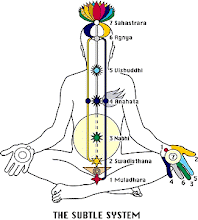Sahaja yoga in the management of moderate to severe asthma: a randomised controlled trial

R Manocha1, G B Marks2,3, P Kenchington4, D Peters and C M Salome2
1 Natural Therapies Unit, Royal Hospital for Women, NSW, Australia
2 Institute of Respiratory Medicine, University of Sydney, NSW, Australia
3 South Western Sydney Clinical School, University of New South Wales, NSW, Australia
4 Concord Psychiatry Unit, NSW, Australia
Correspondence to:
Dr G B Marks, Institute of Respiratory Medicine, P O Box M77, Camperdown, NSW 2050, Australia;
g.marks@unsw.edu.au
Background: Sahaja Yoga is a traditional system of meditation based on yogic principles which may be used for therapeutic purposes. A study was undertaken to assess the effectiveness of this therapy as an adjunctive tool in the management of asthma in adult patients who remained symptomatic on moderate to high doses of inhaled steroids.
Methods: A parallel group, double blind, randomised controlled trial was conducted. Subjects were randomly allocated to Sahaja yoga and control intervention groups. Both the yoga and the control interventions required the subjects to attend a 2 hour session once a week for 4 months. Asthma related quality of life (AQLQ, range 0–4), Profile of Mood States (POMS), level of airway hyperresponsiveness to methacholine (AHR), and a diary card based combined asthma score (CAS, range 0–12) reflecting symptoms, bronchodilator usage, and peak expiratory flow rates were measured at the end of the treatment period and again 2 months later.
Results: Twenty one of 30 subjects randomised to the yoga intervention and 26 of 29 subjects randomised to the control group were available for assessment at the end of treatment. The improvement in AHR at the end of treatment was 1.5 doubling doses (95% confidence interval (CI) 0.0 to 2.9, p=0.047) greater in the yoga intervention group than in the control group. Differences in AQLQ score (0.41, 95% CI –0.04 to 0.86) and CAS (0.9, 95% CI –0.9 to 2.7) were not significant (p>0.05). The AQLQ mood subscale did improve more in the yoga group than in the control group (difference 0.63, 95% CI 0.06 to 1.20), as did the summary POMS score (difference 18.4, 95% CI 0.2 to 36.5, p=0.05). There were no significant differences between the two groups at the 2 month follow up assessment.
Conclusions: This randomised controlled trial has shown that the practice of Sahaja yoga does have limited beneficial effects on some objective and subjective measures of the impact of asthma. Further work is required to understand the mechanism underlying the observed effects and to establish whether elements of this intervention may be clinically valuable in patients with severe asthma.
1 Natural Therapies Unit, Royal Hospital for Women, NSW, Australia
2 Institute of Respiratory Medicine, University of Sydney, NSW, Australia
3 South Western Sydney Clinical School, University of New South Wales, NSW, Australia
4 Concord Psychiatry Unit, NSW, Australia
Correspondence to:
Dr G B Marks, Institute of Respiratory Medicine, P O Box M77, Camperdown, NSW 2050, Australia;
g.marks@unsw.edu.au
Background: Sahaja Yoga is a traditional system of meditation based on yogic principles which may be used for therapeutic purposes. A study was undertaken to assess the effectiveness of this therapy as an adjunctive tool in the management of asthma in adult patients who remained symptomatic on moderate to high doses of inhaled steroids.
Methods: A parallel group, double blind, randomised controlled trial was conducted. Subjects were randomly allocated to Sahaja yoga and control intervention groups. Both the yoga and the control interventions required the subjects to attend a 2 hour session once a week for 4 months. Asthma related quality of life (AQLQ, range 0–4), Profile of Mood States (POMS), level of airway hyperresponsiveness to methacholine (AHR), and a diary card based combined asthma score (CAS, range 0–12) reflecting symptoms, bronchodilator usage, and peak expiratory flow rates were measured at the end of the treatment period and again 2 months later.
Results: Twenty one of 30 subjects randomised to the yoga intervention and 26 of 29 subjects randomised to the control group were available for assessment at the end of treatment. The improvement in AHR at the end of treatment was 1.5 doubling doses (95% confidence interval (CI) 0.0 to 2.9, p=0.047) greater in the yoga intervention group than in the control group. Differences in AQLQ score (0.41, 95% CI –0.04 to 0.86) and CAS (0.9, 95% CI –0.9 to 2.7) were not significant (p>0.05). The AQLQ mood subscale did improve more in the yoga group than in the control group (difference 0.63, 95% CI 0.06 to 1.20), as did the summary POMS score (difference 18.4, 95% CI 0.2 to 36.5, p=0.05). There were no significant differences between the two groups at the 2 month follow up assessment.
Conclusions: This randomised controlled trial has shown that the practice of Sahaja yoga does have limited beneficial effects on some objective and subjective measures of the impact of asthma. Further work is required to understand the mechanism underlying the observed effects and to establish whether elements of this intervention may be clinically valuable in patients with severe asthma.


<< Home